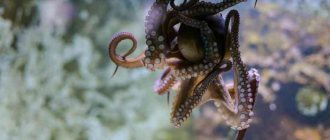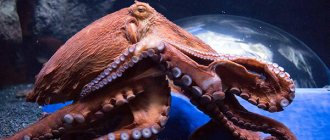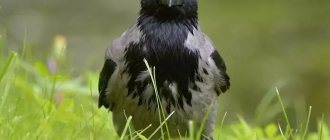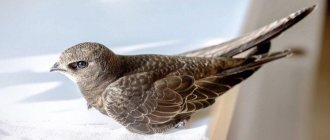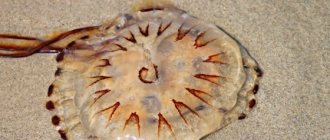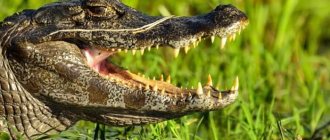Octopuses, or octopuses (lat. Octopus ) are a large order of cephalopods. The age of the most ancient representatives of the order discovered by archaeologists indicates that these animals appeared on the planet at least 90 million years ago. When studying the remains, it was possible to establish that over millions of years of existence, the external and internal structure of cephalopods has practically not changed.
In the process of studying octopuses, many interesting features of structure and behavior were established, and to this day these animals never cease to amaze. Thus, the mollusk genome deciphered in 2015 turned out to be almost as large as that of humans. Not only the physiology, but also the intelligence of the octopus is striking: they have good short-term and long-term memory, are easy to learn, and can use tools.
Characteristics and description
Mimic Indonesian
Octopuses have a brain with a rudimentary cortex, with most of the neurons located in the tentacles. In addition, there are up to 40 million receptors on the surface of each tentacle, which allows them to be used as organs of smell and touch. Mollusks see and perceive sound waves very well, including low-frequency ones that humans cannot hear.
Pacific striped
The surface of the skin consists of cells with pigments of different colors. Under the influence of nerve impulses, they are able to contract or expand, changing the color of the animal. Thanks to the ability to change color and shape, the octopus is very skillfully camouflaged.
Master of Disguise
Octopuses lead a solitary lifestyle. In the dark, their activity increases; during the day, mollusks prefer to hide in shelters: algae thickets, caves, crevices and among stones.
What does it look like
The appearance of octopuses has the following features:
- The body of the mollusk is oval and resembles a folded bag.
- The mouth has two jaws that form a kind of beak.
- Under the head there are tentacles connected by a membrane with suction cups.
What is the difference between an octopus and an octopus?
Squid
The name “octopus” comes from a Greek word whose literal translation is “eight legs.” In the 18th century, a second name for the animal appeared in the Russian language - octopus. It comes from the English word sprout (tentacle). This is what sailors called giant octopuses. Later, in works of art and even in some scientific works, other cephalopods, squids, began to be called octopuses, which caused some confusion in terminology.
Squids and octopuses belong to the same class and indeed have a certain external similarity and a common habitat, but they are different animals. The difference between an octopus and a squid is as follows:
| What you should pay attention to | Octopus | Squid |
| Body | The body is soft, shapeless, the head is not separate, the fins are not developed | Elongated, resembles a torpedo, there is a rudiment of a shell inside, and has fins |
| Number of tentacles | 8 | 10 |
| Features of movement | Mostly crawl | Swimming |
| Suckers on tentacles | Soft | More rigid, there are claws inside |
| Lifestyle | Single | gregarious |
Appearance and features
Photo: Giant octopus
Octopuses are made entirely of soft tissue. Its “head” has an oval shape, from which eight movable tentacles grow. The mouth with jaws that resemble the beak of a bird is located at the point where all the tentacles converge - the octopuses grab the victim and pull it into its center. The anus is located under the mantle, a leathery sac behind the squid.
The octopus's pharynx is ribbed, called the “radula,” and functions as a grater for food. The octopus' tentacles are connected by a thin, stretchy membrane. Depending on the size of the octopus, its tentacles may have one or three rows of suckers. An adult octopus has a total of about 2 thousand suckers, each of which can hold about 100 grams of weight.
Interesting fact: Octopus suction cups do not work like man-made suction cups - in a vacuum. The octopus attaches itself using muscle effort.
The octopus is also interesting because it has three hearts. The first drives blood throughout the body, and the other two hearts act as gills, pushing blood through for respiration. Some species of octopus have poison, and blue-ringed octopuses, which live on the Pacific coast, are ranked among the most poisonous animals in the world.
Fun fact: Octopuses have blue blood.
Octopuses have absolutely no bones or any kind of frame, which allows them to freely change shape. They can spread out along the bottom and disguise themselves as sand, or they can climb into the neck of a bottle or a narrow crevice in the rocks. Octopuses are also capable of changing their color to suit their environment.
Octopuses vary in size. The smallest representatives can reach a length of 1 cm, the largest - (Doflein's octopus) - 960 cm with a mass of 270 kg.
Octopus species
The order Octopus includes the extinct family Palaeoctopodidae and two modern suborders: deep-sea octopuses and common octopuses. The total number of species known to science has reached 200. Let us briefly dwell on the most interesting representatives:
- Mimic Indonesian octopus . The view was opened in 1998. It has the ability to very accurately copy more than a dozen sea animals, including stingrays, flounder, jellyfish, and sea snakes.
- Pacific striped octopus . The only species capable of forming colonies of up to 40 individuals. Females lay eggs not at once, but in portions, and spawning can last up to six months.
- Coconut octopus. Small shellfish that get their name from the use of coconut shells as shelter. The animals pick up the shell, place one half at the bottom and lay it down, and cover the other half on top.
- Deep sea octopus Dumbo. It has two small processes in the form of fins and with their help it moves above the bottom surface in search of worms and crustaceans. Dumbos are capable of not only changing color, but also becoming almost completely transparent.
- Blue-ringed octopus . Small mollusks, the distinctive feature of which is bright blue rings located along the body. Ringed octopuses are quite aggressive and are considered the most dangerous among poisonous animals.
- Violet tremoctopus . Females have an additional sail-like mantle, which is hidden in a pouch near the mouth. In case of danger, they throw it out and straighten it, due to which they significantly increase in size.
Alien Mind
The common ancestor of humans and octopuses lived 750 million years ago. The supercontinent Rodinia still existed, the Cambrian explosion had yet to occur, and dinosaurs still needed tens and hundreds of millions of years to appear. The common ancestor was a big-eyed worm, so it’s not surprising that now the octopus’s brain is strikingly different from the brain of mammals or birds
What's important to us is to know how big the difference is between the intelligence of humans and octopuses
In an octopus, the brain is not in one place, like ours, but is scattered throughout the body: one part is where it should be (in the head), then there is a small copy of it in each of the tentacles and another “backup copy” behind the eyeballs apples. Moreover, each of these think tanks is independent. This means that the octopus's tentacles can move independently of each other and without direct orders from the "main" brain. It would be the same if our hands could move on their own, sometimes alone, sometimes in pairs, listening to the instructions of the brain or ignoring them. We simply cannot understand how such a mind functions. And it's really creepy.
Where does the octopus live?
Blue-ringed
habitat extends to tropical and subtropical zones. Cephalopods are found in all seas and oceans with suitable climatic conditions.
Habitat
Coconut
Octopuses live only in salt water. Representatives of the suborder of common octopuses prefer to settle in coastal areas with a depth of up to 100-150 m and a rocky bottom. Deep-sea species are found at depths of 3000 m or more.
How do they reproduce?
In most octopuses, reproduction occurs only once: having given birth to offspring, they die from exhaustion.
Cephalopods mate in the following way: the males release spermatophores into the mantle cavity of the female, inserting a sexual tentacle, the hectocotylus, into one of the siphon openings. The fluid released by the male enters the female's oviduct and fertilizes the eggs during laying.
Sometimes females, after mating, strangle their partner with tentacles. They drag dead males into their lair and eat them. In species with developed intersexual cannibalism, males try to stay as far as possible from the female, extending the hectocotylus to a length twice the length of the tentacles. Some species of molluscs detach their completed sexual tentacle and leave it to the female.
Females hide the laid eggs in holes, glue them to the walls of crevices and caves, or glue them into small clusters and carry them with them. All the time before the hatchlings appear, they monitor the eggs, remove any debris that gets on the clutch and direct streams of fresh water towards them. The duration of egg maturation varies from 4-5 months to a year or more in some species of deep-sea mollusks. All this time the female does not hunt or eat. Octopuses are born completely independent.
Reproduction
During the mating period, the male approaches the female and begins to caress her with his tentacles, after which he covers the female’s mantle with them and begins the process of fertilization.
Mating will last as long as the female allows. Some species are forced to forcefully push the male away from them. During the mating season, male blue-ringed octopuses are extremely active and excited; they want to mate with absolutely all their relatives, regardless of the age and even gender of the partner. Mating between males is short-lived and occurs without fertilization.
After mating, the female makes the first and last clutch in her life. She lays about 50 eggs at the end of autumn, and for six months she tirelessly and carefully monitors the future offspring, without even taking food. As a result, after the small octopuses are born, the female dies. Thus, their life expectancy is a maximum of 1.5 years.
After nursing the offspring, the female octopus dies.
Blue-ringed octopuses reach sexual maturity at the age of 1 year, after which they are ready to mate.
What do they eat
The octopus's diet is based on crabs, lobsters, shrimp, and bivalves. In search of food, it moves along the bottom or comes ashore. Octopuses pull out crustaceans hidden in shelters with their tentacles, penetrating even the smallest crevices.
The mollusk feeds on fish very rarely. When a school approaches, it opens like a net and captures passing fish.
The animal grabs the prey it finds or catches with its tentacles and stuffs it into its mouth. The oral cavity is covered with a radula - a chitinous plate with sharp growths used for grinding food.
Octopus body
Each octopus has three hearts. One of them has to pump blood around the body. The remaining two are assigned the role of pushing it through the gills.
The sizes of the brain and body are almost the same, because octopuses are quite developed invertebrates. They are able to distinguish between people and geometric shapes. They can also be trained.
The tentacle is covered with many receptors, the number of which exceeds 10 thousand. They are necessary for the octopus to make a decision about the edibility and taste of the found item.
Octopus blood is blue.
The creature's body is soft, elastic, and its only dense part is its beak, which resembles a parrot's. Therefore, the creature is able to penetrate into any crevice corresponding to the size of its beak.
The shape of octopus pupils is rectangular. A similar feature is found in few creatures.
What does it breathe?
The respiratory organs of an octopus are gills. Despite the fact that the respiratory system is adapted to life in water, the animal is able to go to land and stay there, searching for food. Before going ashore, the octopus fills the mantle cavity with water. He can breathe the oxygen contained in the water for 3-4 hours.
DOLPHINS
What organ is similar in structure to humans and octopuses?
When studying the animal, a striking similarity between the eyes of an octopus and a human was revealed. The so-called convergent similarity (common characteristics in organisms of different systematic groups) is expressed in the presence of:
- retina;
- lens (in a cephalopod it is more rounded due to different degrees of refraction of light in air and water);
- pupil (has a rectangular shape);
- iris;
- cornea.
Octopuses can also focus their vision on objects located at different distances, but focusing in them occurs not due to a change in the curvature of the lens, but by bringing it closer or further to the retina.
Octopus eyes - how an octopus sees in water
What surprises scientists most is that the structure of our eye and the octopus are surprisingly similar, however, they are as similar as they are different. The difference lies in the thin structure of the retina. Our eye is built “inside out” - the retina, which is located at the bottom of the posterior chamber of the eye, lies under a layer of nerve fibers formed by “ganglion”, “amacrine”, bipolar and horizontal cells.
Therefore, light entering through the cornea must first pass through these layers of cells before reaching the light-sensitive receptors - rods and cones. In octopuses, the opposite is true - light receptors lie on the surface of nerve fibers. But that's not the whole difference.
Vertebrates have a so-called “blind spot” - this is the point of convergence of nerve fibers from light receptors, which does not perceive either light or images, but cephalopods do not have it, because their nerves are sensitive cells.
These differences are much deeper than it seems at first glance - they indicate different ways of forming eyes in these groups of animals. In octopuses, the eyes are evolutionary and, accordingly, “embyronal”, formed as a result of deflection (invagination) of the surface of the scalp, and in vertebrates - due to the growth of processes of the brain (neural tube).
If an octopus has the opposite eye structure, then how does it see? But it is impossible for us to get into its “skin” and look at the underwater world and its inhabitants through the eyes of an octopus. This is again another mystery for us.
Eyes of an octopus - how an octopus sees in water Eyes of an octopus - how an octopus sees in water
Octopuses are perhaps the most amazing of the mollusks that live in the depths of the sea. Their strange appearance surprises, delights, and sometimes frightens, the imagination pictures giant octopuses capable of easily sinking even large ships. This kind of demonization of the octopus was greatly facilitated by the work of many famous writers, for example, Victor Hugo described in his novel “Toilers of the Sea” octopus as “the absolute embodiment of evil.” In reality, octopuses, of which there are more than 200 species in nature, are completely harmless creatures, and it is rather they who need to be afraid of us humans, and not vice versa.
The closest relatives of octopuses are squid and cuttlefish; they themselves belong to the genus of cephalopods, the family of octopuses proper.
How many hearts does an octopus have: correct answer
The circulatory system in animals functions as follows: first, the heart sends blood to the lungs, where it is enriched with oxygen, and then to all organs and tissues to ensure their respiration and metabolic processes.
The circulatory system of the octopus works the same way, but has one significant difference: the blood is pushed through the vessels not by one, but by three hearts . This feature is due to the fact that the gills of the mollusk have a very dense structure. In front of each of them there is an additional heart, which increases the pressure in the vessels and facilitates the passage of blood through the respiratory organs. Oxygenated blood enters the main three-chambered heart, which pushes it throughout the body.
JELLYFISH
Useful and harmful properties
The beneficial and harmful properties of octopus have long been known. If we talk about the benefits that octopus meat has on the human body, it is important to note that it lies in the composition of the product. The shellfish is rich in proteins, water, ash and fats.
The energy value of octopus lies in its composition: 100 grams of meat contains 14.91 grams of protein, 1.04 grams of fat and 2.2 grams of carbohydrates. The calorie content of octopus is 82 kilocalories (per 100 g of meat weight), from which we can conclude that the product, when properly prepared, is considered dietary, and therefore unlimited for consumption by people on a diet, prone to excess weight, and also by those who suffer from certain diseases of the gastrointestinal tract.
There are a lot of B vitamins in meat, especially vitamin B12 - a natural antioxidant that helps saturate the body's cells with oxygen. In addition, the composition includes vitamins of groups A, C and PP.
A large number of useful elements such as phosphorus, selenium, magnesium, iron, potassium, zinc, where the latter has a rejuvenating effect on the skin and also strengthens the human immune system as a whole.
Fatty acids are of great benefit, especially Omega-3, the value of which is incredibly high. On average, 350 mg of this element is contained in just 100 grams of the product. This is quite a large figure. For this reason, octopus has a beneficial effect on blood vessels and the heart, and therefore is beneficial for the entire cardiovascular system. Acids remove “bad” cholesterol from the body, increasing the amount of only “good” cholesterol in the blood.
The value of this sea creature is not only in its meat, but also useful substances are contained in the liquid secreted by octopuses, which is called “ink”. They have a dark color shade, are persistent, and therefore are used as a dye.
Octopus only causes harm to people who have an individual intolerance to the product. It is important to take into account the animal’s habitat: if it is polluted water, then the meat could be filled with toxic and other harmful substances, and therefore should not be eaten. If you try a dish made from low-quality meat, you can get poisoned and disrupt the functioning of your stomach and intestines.
Be quite serious about preparing octopus food and saturate your body exclusively with vitamins, micro- and macroelements, and other beneficial substances. The health value of this seafood is great.
Why does an octopus secrete ink?
At the moment of danger, cephalopods eject a stream of dark liquid that resembles ink. As a result, a cloud forms in the water, the size and outline of which resembles the animal itself. The octopus's skin becomes noticeably lighter when the ink is released. This camouflage helps confuse the pursuer and evade pursuit.
In addition, it was found that the substances contained in the ink paralyze the sense of smell of predators hunting the octopus. Even being in close proximity to the victim, moray eels, sharks and other natural enemies of the mollusk cannot recognize its smell.
Correct selection and storage
Correct selection and storage. Either you bring octopus back from fishing, knowing for sure that it is fresh, or you go shopping at the store. The second option is more risky, because it is not known how long the mollusk has been waiting in the wings on the counter. In order to buy fresh octopus, which will have incredibly tasty, tender meat, which will result in an exquisite dish or a delicacy in its pure form, you need to know a few rules.
- The eyes of a sea creature. If you are going to buy a whole octopus carcass, be sure to look at its eyes - they should be extremely transparent.
- Color of the skin. Most often, carcasses are not sold large, but are divided into smaller pieces. When planning to buy tentacles, be sure to look at the color of their skin. If the product is fresh, the octopus meat is of high quality, which means it should be brown and shiny. If you see any damage on the skin, as well as black spots, you can conclude that what you have in front of you is not very high-quality, or rather, not at all high-quality products that were stored in inappropriate conditions.
- Elasticity of meat. How to check this factor? Very easy: press on the surface of the octopus and observe how quickly the formed dimple is restored. If you do so immediately, you can buy this octopus meat - it is fresh.
There are important nuances regarding storage: it is not recommended to store octopus fresh. First of all, you should cook the loot or purchase, then only put it in the refrigerator for storage in a vacuum container. However, it is important to remember that octopus should not lie in a boiled state for more than three days. After this time, the product is considered spoiled.
Meaning in nature and human life
Octopuses play an important role in marine and ocean ecosystems: they serve as food for large species of fish, sharks, seals, dolphins and other mammals.
Octopus meat is considered a dietary product and is valued for its high protein content. A variety of dishes from cephalopods are found in many cuisines of Asian countries.
The secretion of the animal's ink gland is used to make sepia watercolor paint.
FISH DROP
Product history
The history of eating octopus dates back to ancient times. The delicacy gained its greatest popularity during the period of Antiquity. Large octopuses were cut into pieces, rubbed with herbs and spices, combined with dough and served in the form of a large warm pie.
In Mediterranean countries, octopuses have been the culinary leader for many years. Snacks and simple seafood dishes are a favorite food of the locals and an indispensable element of folk culinary culture.
In Spain, baking octopus tentacles with dough is especially popular. Local residents of Barcelona cannot imagine their life without delicacy. In every store you can find sets of stuffed seafood that have been heat-treated and are ready to eat. They are simply heated and served as a main course.
In Japan, they prefer to fry octopus in oil; in Polynesia, they prefer to dry it and then boil it in coconut milk or bake it in an earthen oven.
Today you won’t surprise anyone with a sandwich with octopus meat.
New ways of preparing dishes cause genuine delight. Modern cooking is busy with unusual combinations, preparing sweet octopuses, and searching for the perfect sauce for the delicacy. And each of us can make our own contribution to the history of culinary searches. Nutritional value (in grams per 100 grams of product)
| Squirrels | 15 |
| Fats | 1 |
| Carbohydrates | 2,2 |
| Water | 80,25 |
| Alimentary fiber | 0 |
| Calorie content | 82 kcal |
Vitamin composition (in milligrams per 100 grams of product)
| Choline (B4) | 65 |
| Nicotinic acid (PP) | 2,1 |
| Phylloquinone (K) | 0,0001 |
| Tocopherol (E) | 1,2 |
| Ascorbic acid (C) | 5 |
| Cyanocobalamin (B12) | 0,02 |
| Pyridoxine (B6) | 0,36 |
| Pantothenic acid (B5) | 0,5 |
| Riboflavin (B2) | 0,04 |
| Thiamine (B1) | 0,03 |
| Retinol (A) | 0,045 |
| Cobalamin (B12) | 0,02 |
| Folic acid (B9) | 0,016 |
Mineral composition (in milligrams per 100 grams of product)
| Selenium | 0,0448 |
| Manganese | 0,025 |
| Copper | 435 |
| Zinc | 1,68 |
| Iron | 5,3 |
| Phosphorus | 186 |
| Calcium | 53 |
| Magnesium | 30 |
| Sodium | 230 |
| Potassium | 350 |
| Omega-3 | 350 |
Interesting facts about octopuses
Violet tremoctopus
- Octopuses are able not only to remember and recognize people, but also to show certain emotions towards them.
- All octopus species are poisonous animals. Their venom contains substances that speed up the digestion of food.
- The largest octopus in the world, listed in the Guinness Book of Records, weighed 58 kg. The length of its tentacles is 3.5 m. The giant belonged to the Doflein octopus species.
- If the octopus remains inside its ink cloud for a long time, it may die.
- Each tentacle of the mollusk has up to 250 suckers, with which it is able to hold prey weighing up to 15 kg.
- Octopuses are capable of experiencing stress, which is manifested by autophagy: a frightened animal can eat its own limbs.
- Many northern European legends mention a giant cryptid octopus. This is a mythical creature of enormous size that attacks ships and drags them into the sea.
Cooking at home
Cooking at home is not as difficult as it might seem at first glance. You don’t have to go to a restaurant or choose expensive dishes to enjoy the unforgettable taste of marine meat. You can prepare equally wonderful fried, dried, boiled, dried, smoked, stewed, pickled octopus at home with your own hands. It is important to follow general cooking recommendations.
- Frozen octopus must be defrosted before cooking. But this is done in two stages: first, the shellfish is transferred from the freezer to the refrigerator, and then taken out and defrosted in natural conditions.
- To make the meat of fresh octopus softer, more tender, and more piquant, initially put it in the freezer for two days or use another method: fill two containers with hot water and another with cold water, and then transfer the mollusk back and forth from boiling water to cold water and vice versa. Six times will be enough.
- Rinse the octopus thoroughly under running water, paying special attention to the suckers and tentacles. The entrails are removed from the body, after which the carcass is turned inside out to ensure that their actions are correct. The eyes and “nose” are cut out with scissors. After all these manipulations, the octopus needs to be thoroughly washed again in water under strong pressure. This will allow you to get rid of ink and mucus.
- If you need to peel a clam, place it in a container, fill it with water, place it on the stove and boil for up to 10 minutes. Then just cool and pull off the skin. This is very easy to do with boiled octopus.
- The time it takes to cook an inhabitant of the deep sea depends on the size of its carcass. If the octopus is small, medium, small, then you need to cook it for 5 minutes and no more. If the mollusk is large in size, weighing up to three kilograms, then it undergoes heat treatment for 30 minutes.
- How to check if the octopus is ready? Take a fork and try to pierce the thickest surface - the head. If this is done easily, it means the shellfish is cooked. The water is not salted during cooking, and the carcass is placed in the vessel when the liquid boils.
- Octopus is rarely fried in a frying pan, and if it is done, it is done before the meat is stewed. If you plan to cook the meat of this waterfowl at home for barbecue, grill it over coals, or grill it, then you should first marinate it. The most optimal sizes of pieces are in a length-to-width ratio of 8:2. In order for the shellfish meat to be well saturated with marinade, spices and herbs, it needs about 40 minutes.
- Fried shellfish should be simmered in a frying pan for 25 minutes.
- If you want to get baked octopus, you must peel it. The shellfish is beaten and placed in the oven for 10 minutes. To prepare it, you need to preheat the oven to 200 degrees. After the specified period of time, the meat is removed, treated with sauce, and then placed in the oven again for an additional 10 minutes, temperature 250 degrees. You can bake octopus with potatoes or other vegetables, mushrooms, and other products. It turns out to be an excellent delicacy.
As you can see, preparing octopus at home is quite simple. Don’t be intimidated by denying yourself wonderful dishes made with your own hands. On the contrary, you can experiment with spices, herbs, and herbs, but it is imperative to adhere to the recommendations listed above.
Octopus is an amazing product that, in addition to excellent taste, contains useful substances that have a positive effect on the human body. We also invite you to watch the video in which we will share an interesting recipe for an exotic octopus dish.
